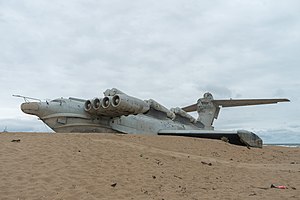 Beached Ekranoplan
| |
| Class overview | |
|---|---|
| Name | Lun |
| Operators | |
| In service | 1987–late 1990s |
| Planned | 2 |
| Completed | 1 |
| Cancelled | 1 |
| Retired | 1 |
| Preserved | 1 |
| General characteristics | |
| Type | Attack/transport ground effect vehicle |
| Displacement | Displacement n/a, weight 286 tonnes unloaded |
| Length | 73.8 m (242 ft 2 in) |
| Beam | (Wingspan) 44 m (144 ft 4 in) |
| Height | 19.2 m (63 ft 0 in) |
| Draught | (2.5 m (8 ft 2 in) |
| Propulsion | 8 × Kuznetsov NK-87 turbojet engines, 127.4 kN (28,600 lbf) thrust |
| Speed | 297 knots (550 km/h; 342 mph) |
| Range | 1,000 nmi (1,900 km; 1,200 mi) |
| Capacity | 100 tonnes (220,000 pounds) |
| Complement | six officers and nine enlisted men |
| Sensors and processing systems | Puluchas search radar |
| Armament |
|
The Lun-class ekranoplan (Soviet classification: Project 903)[1] is the only ground effect vehicle (GEV) to ever be operationally deployed as a warship, deploying in the Caspian Flotilla. It was designed by Rostislav Alexeyev in 1975 and used by the Soviet and later Russian navies from 1987 until sometime in the late 1990s.[2][3]
It flew using lift generated by the ground effect acting on its large wings when within about four metres (13 ft) above the surface of the water. Although they might look similar to traditional aircraft, ekranoplans like the Lun are not classified as aircraft, seaplanes, hovercraft, or hydrofoils. Rather, craft like the Lun-class ekranoplan are classified as maritime ships by the International Maritime Organization due to their use of the ground effect, in which the craft glides just above the surface of the water.[4]
The ground effect occurs when flying at an altitude of only a few metres above the ocean or ground; drag is greatly reduced by the proximity of the ground preventing the formation of wingtip vortices, thus increasing the efficiency of the wing. This effect does not occur at high altitude.[5][6]
The name Lun comes from the Russian word for the harrier.[7]
- ^ "Small Missile Ship-Ekranoplan - Project 903". russianships.info. Archived from the original on 2 October 2024. Retrieved 24 November 2023.
- ^ Shukla, Vikas (9 September 2015). "Russia Revives Its Soviet-Era Ekranoplan Project". ValueWalk. Retrieved 10 September 2015.[permanent dead link]
- ^ Johnson, Robert; Rosen, Armin. "Here's The Astonishing Hovercraft That The Soviets Could Have Used To Invade Western Europe In The 80s". Business Insider. Archived from the original on 21 September 2015. Retrieved 10 September 2015.
- ^ Liang Yun; Alan Bliault; Johnny Doo (3 December 2009). WIG Craft and Ekranoplan: Ground Effect Craft Technology. Springer Science & Business Media. pp. 436–. ISBN 978-1-4419-0042-5.
- ^ Cui, E.; Zhang, X. (2010). "Chapter 18 Ground Effect Aerodynamics". S2CID 29236092.
{{cite journal}}: Cite journal requires|journal=(help) - ^ "Here's a Closer Look at the Soviet Navy's 1987 Lun-Class Ekranoplan". interestingengineering.com. 4 April 2017. Archived from the original on 2 October 2024. Retrieved 31 July 2021.
- ^ "Neither Fish Nor Fowl". Flying: 72. July 1994. ISSN 0015-4806.
